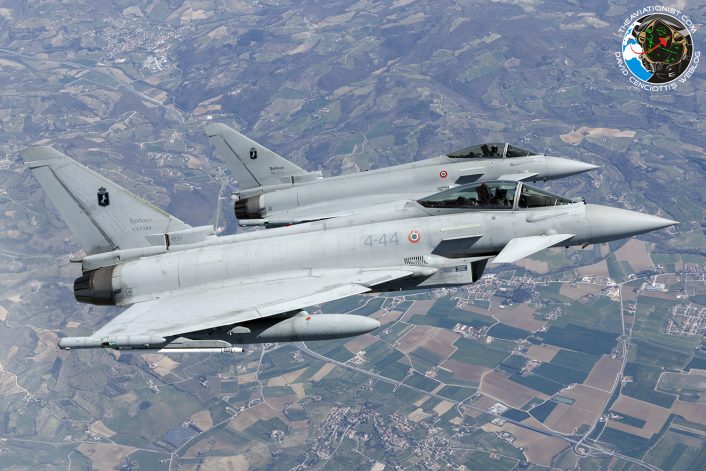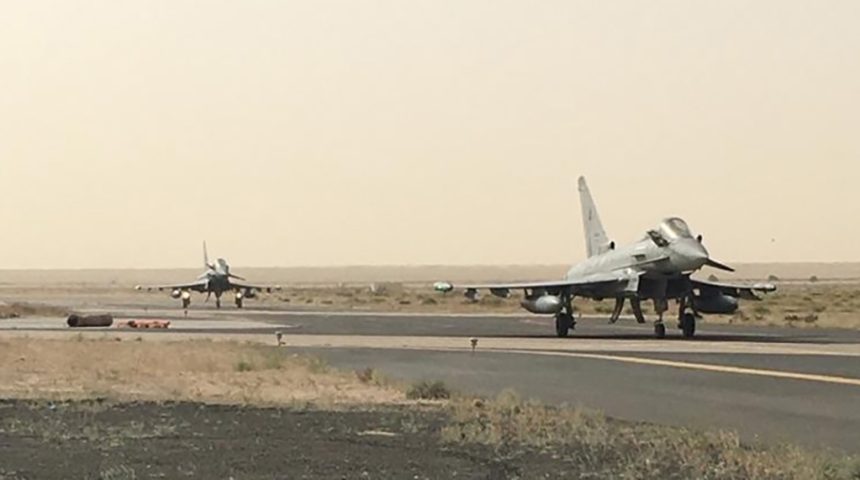The Italian Air Force Typhoons have arrived at Alì Al Salem Air Base, Kuwait.
Four F-2000A Typhoon jets, belonging to the Aeronautica Militare (Italian Air Force) have deployed to Kuwait, to support Operation Inherent Resolve, the multinational campaign against Daesh in Iraq and Syria, as part of “Prima Parthica”, as the Italian Armed Forces operation is dubbed at national level.
While it’s not the first time the Italian Typhoons deploy to Kuwait, it’s the very first time since the Italian National Contingent Command Air – Task Force Air Kuwait has been established in 2014, that the Italian combat aircraft operate out of Alì Al Salem Air Base (west of Kuwait City): during their previous tour of duty in support of OIR, from Mar. 26, 2019 to Aug. 12, 2020, the Italian Eurofighters were stationed at Ahmed Al Jaber airbase (located to the south of Kuwait City).
In the next weeks, the Typhoons, belonging to the 4° Stormo (Wing), from Grosseto Air Base, and 36° Stormo, from Gioia del Colle, and operating within the Task Group “Typhoon”, will replace four Tornado IDS aircraft of the 154° Gruppo (Squadron) of the 6° Stormo (Wing) of the Italian Air Force, operating as part of the Task Group “Devil” at Ahmed Al Jaber airbase.
The “Typhoon trail” was supported by a KC-767 aircraft of the 8th Squadron/14th Wing from Pratica di Mare, that rejoined with the Eurofighters over the Ionian Sea, where the first of three aerial refuelings that allowed the aircraft to reach their destination after about 4.5 flight hours. Shortly after they arrived at Alì Al Salem, the Typhoons have launched the first Local Area Orientation sorties, which included missions over the local ranges in coordination with U.S. JTACs (Joint Terminal Attack Controllers).
The F-2000s (as the Italian single-seat “Tiffies” are designated) will carry out the same mission flown by the Tornado (and previously, the AMX A-11 Ghibli): Intelligence Surveillance and Reconnaissance using the Rafael RecceLite II pod.
The Rafael Reccelite reconnaissance pod, integrated on the Typhoon since 2015, is the Italian Air Force’s tactical pod of choice to carry out ISR missions: the it is a Day/Night electro-optical pod able to provide real-time imagery collection. It is made of a stabilized turret, solid-state on board recorder that provides image collections in all directions, from high, medium and low altitudes. The Reccelite reconnaissance pod is used to broadcast live video imagery via datalink to ground stations and to ROVER (Remote Operations Video Enhanced Receiver) tactical receivers in a range of about 100 miles.
As explained in a recent article about the integration of the GBU-48 Enhanced Paveway II bombs with the Typhoon fleet for “Swing Role” missions, much has changed since the times the Italian Air Force saw the Eurofighter as an air superiority platform. Here’s what this Author wrote about the “transformation” we have observed in the last years:
While the integration of the new bombs is interesting, what’s even more remarkable is the fact that the Italian Air Force has become quite vocal about the “Swing Role” capabilities of its F-2000s (the Italian designation for the Typhoon is F-2000A, for the single seater, and TF-2000A, for the two seater).
As we reported in detail throughout the years, unlike other partner nations, the Italian Air Force hadn’t initially planned to employ the Typhoon is the air-to-surface role. In 2016, when the Italian Typhoons took part in their first Red Flag exercise, three of the Typhoons deployed at Nellis Air Force Base, Nevada, were Tranche 2 examples that embedded the P1E(B) upgrades and were loaded with the latest Software Release Package. The two T2 Typhoons carried also two inert GBU-16 Paveway II LGBs (Laser Guided Bombs) and the Litening targeting pod in order to validate the tactics being developed since the aircraft started the OT&E (Operational Testing & Evaluation) in 2015. At that time, the Italian Air Force claimed the Swing Role capability was being developed only to support the platform’s export capabilities and help the industry promoting the aircraft in particular regions (like Kuwait).
“Air superiority remains our primary mission,” told us Col. Pederzolli, commander of the 4° Stormo, during an interview in 2016. “However, last year, using the software releases that embed a significant air-to-surface potential we have started flying Swing Role missions with the aim to get a limited secondary air-to-ground capability.”
Following the Red Flag participation, a team of experienced Eurofighter pilots was destined to the new role and those aircrews who were already dual role qualified took part in a TLP (Tactical Leadership Programme) course at Albacete flying the Swing Role mission.
Many things have changed since then.
Despite the domestic criticism, Italy has started receiving its first F-35A (and then B) Lightning II jets, that the Italian Air Force has declared IOC (Initial Operational Capable) at the end of 2018 during the first 5th gen. TLP training course held at Amendola Air Base, home of the 32° Stormo, the first Italian Lightning unit. The stealth aircraft has then been more or less accepted by the public opinion and has already carried out two overseas missions under NATO command and has also achieved IOC in the QRA (Quick Reaction Alert) role, showcasing the willingness of the Italian Air Force to exploit the F-35 not only in the air-to-surface but also in the air-to-air role. This has also paved the way for a gradual expansion of the Eurofighter tasks with more communication being done around the Swing Role capabilities of the F-2000s.










